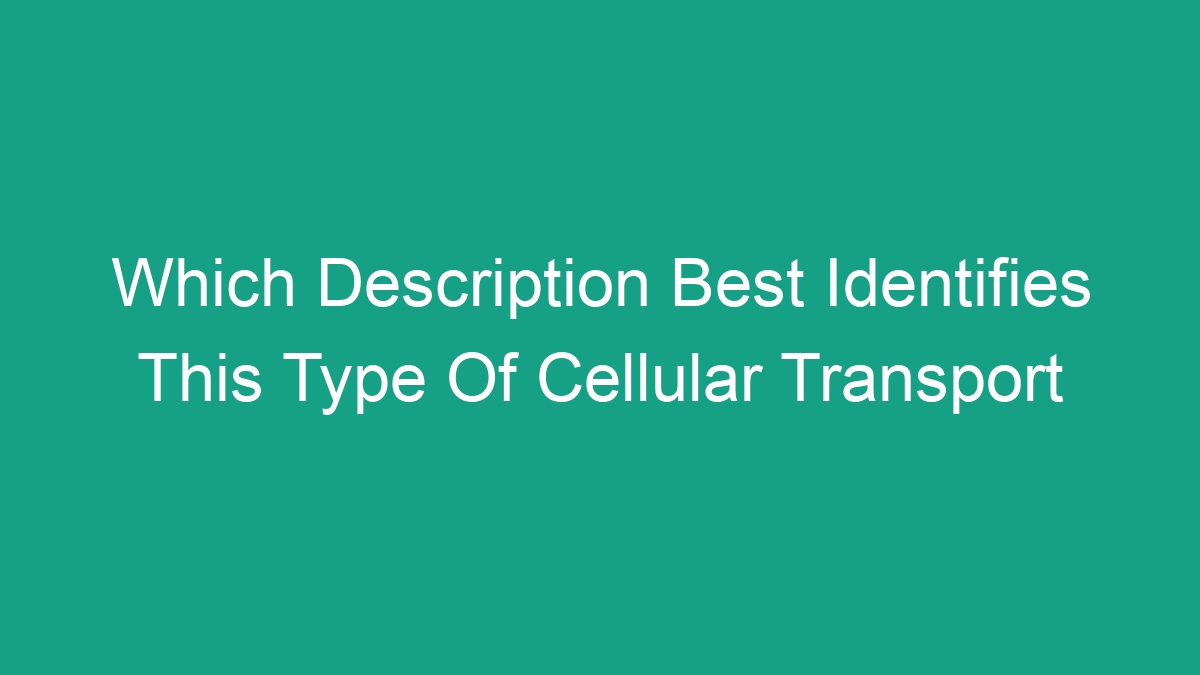
H1: Exploring Different Types of Cellular Transport: Which Description Best Identifies This Phenomenon
H2: Introduction to Cellular Transport
Cellular transport refers to the movement of materials across the cell membrane. This process is crucial for the survival and proper functioning of cells. There are different types of cellular transport, each serving specific functions. These include passive transport, active transport, and vesicular transport.
H2: Passive Transport
Passive transport is a type of cellular transport that does not require the cell to expend energy. Instead, it relies on the natural kinetic energy of molecules to move across the cell membrane. There are two main types of passive transport: diffusion and facilitated diffusion.
Diffusion is the process by which molecules move from an area of high concentration to an area of low concentration. This movement occurs until a state of equilibrium is reached, where the concentration of molecules is equal throughout the space. Diffusion is essential for the exchange of gases such as oxygen and carbon dioxide in the lungs, as well as the movement of nutrients in and out of cells.
Facilitated diffusion, on the other hand, involves the assistance of transport proteins to move molecules across the cell membrane. These proteins act as channels or carriers, aiding in the movement of specific molecules that would otherwise have difficulty passing through the lipid bilayer of the membrane. Facilitated diffusion is necessary for the transport of larger or charged molecules such as glucose and ions.
H2: Active Transport
In contrast to passive transport, active transport is a cellular process that requires the cell to expend energy in the form of adenosine triphosphate (ATP) to move molecules against their concentration gradient, from an area of low concentration to an area of high concentration. This process allows the cell to maintain internal concentrations of certain molecules that are different from their surroundings.
One common example of active transport is the sodium-potassium pump, which is responsible for maintaining the electrochemical gradient across the cell membrane. This pump uses ATP to move three sodium ions out of the cell and two potassium ions into the cell, against their concentration gradients. This process plays a crucial role in nerve cell function and muscle contraction.
Another form of active transport is endocytosis and exocytosis, which involve the movement of larger molecules or particles into and out of the cell using vesicles. Endocytosis encompasses phagocytosis, pinocytosis, and receptor-mediated endocytosis, while exocytosis involves the secretion of cellular products such as hormones and neurotransmitters.
H2: Vesicular Transport
Vesicular transport, as mentioned earlier, involves the movement of materials into and out of the cell using vesicles. This process is essential for the transport of large molecules, such as proteins, and the maintenance of the cell’s internal environment. Vesicles are small, membrane-bound sacs that are used to transport materials within the cell or to and from the cell membrane.
One type of vesicular transport is endocytosis, where materials are taken into the cell by invagination of the cell membrane to form a vesicle. This process can occur through phagocytosis, which involves the ingestion of large particles such as bacteria or cellular debris, or pinocytosis, which involves the uptake of fluids and solutes. Receptor-mediated endocytosis is a highly specific form of endocytosis that requires the binding of specific molecules to receptor proteins on the cell surface.
On the other hand, exocytosis involves the fusion of vesicles with the cell membrane, releasing their contents into the extracellular space. This process is essential for the secretion of cellular products, such as hormones, enzymes, and neurotransmitters. It also plays a role in the insertion of new membrane components and the regulation of membrane surface area.
H2: Which Description Best Identifies This Type of Cellular Transport
When considering which description best identifies a particular type of cellular transport, it is important to look at the key characteristics and mechanisms involved in each process. For passive transport, the movement of molecules occurs spontaneously, driven by the concentration gradient, without the need for energy expenditure by the cell. In contrast, active transport requires the input of energy to move molecules against their concentration gradient.
Vesicular transport involves the use of membrane-bound vesicles for the transport of materials into and out of the cell, enabling the movement of larger molecules and the regulation of the cell’s internal environment. When identifying the type of cellular transport, it is crucial to understand the specific mechanisms and processes involved in each type, as well as their significance in maintaining cell function and homeostasis.
In conclusion, cellular transport is a fundamental process that allows for the movement of materials across the cell membrane, impacting various cellular functions and physiological processes. Understanding the different types of cellular transport, including passive transport, active transport, and vesicular transport, is essential for gaining insights into the mechanisms that underlie the proper functioning of cells.
Whether it is the spontaneous movement of molecules in passive transport, the energy-driven transport against the concentration gradient in active transport, or the use of vesicles for the transport of materials in vesicular transport, each type of cellular transport serves a distinct purpose in maintaining cellular homeostasis and facilitating the exchange of essential molecules. Identifying the best description for each type of cellular transport involves recognizing their specific characteristics and mechanisms, and understanding their significance in cellular physiology and human health.



